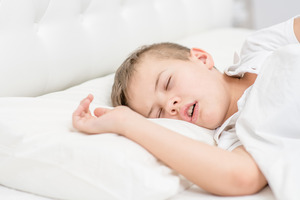
Sleep apnea is an all-too-common sleep disorder that can cause a person to experience frequent pauses in their breathing while asleep. While the disorder is typically associated with adults, the fact of the matter is that even children can develop it under certain circumstances. Could your own child be struggling with sleep apnea? Here’s a closer look at what causes sleep-disordered breathing in children as well as what symptoms parents need to watch out for.
What Can Cause Sleep Apnea in Children?
Most of the time, sleep apnea is the result of the airway being obstructed in some manner. In children, the obstruction is often caused by relaxed muscles in the back of the throat. However, it can also be due to tonsils or adenoids that are larger than normal. Additionally, sleep apnea can occasionally be related to the shape of your child’s face or head.
What are the Symptoms of Sleep Apnea in Children?
If your child has sleep apnea, they may snore, snort, gasp, cough, or choke in their sleep. You may also observe pauses in their breathing as well as restlessness. Other symptoms that can occur while your child is asleep include mouth breathing, sweating, and bedwetting.
As a result of sleep apnea preventing them from getting a good night’s rest, your child may have trouble focusing during the day, which can lead to poor performance at school. They could also start acting overly hyper or exhibit other behavioral issues. On top of that, they may mention feeling sleepy more often than normal, and they might develop a tendency to fall asleep during car rides.
What Should You Do If Your Child Has Sleep Apnea?
Untreated sleep apnea can ultimately lead to a number of health complications, including high blood pressure, elevated blood sugar levels, and a variety of heart problems. In order to protect your child’s health and quality of life in the long run, you should have their sleep apnea treated as soon as possible.
Step one is to get a proper diagnosis. If you suspect that your child has sleep apnea, you should make arrangements to have a sleep study performed. This will allow a sleep expert to determine whether your child is truly suffering from sleep-disordered breathing so that the issue can be addressed properly.
The exact method of sleep apnea treatment that your child requires depends on the underlying cause of their disorder. Sometimes it might involve removing their tonsils and adenoids so that they can no longer block the flow of air. In other cases, an oral appliance may be recommended to reposition the jaw and maintain a clear airway.
Do you have any reason to think that your child has sleep apnea? If so, now’s the best time to start seeking care; acting quickly could be the key to helping your little one avoid the most severe consequences of sleep-disordered breathing.
About the Author
Dr. Tad Morgan is a graduate of Baylor College of Dentistry, and he holds membership with a variety of dental organizations, including the Texas Dental Association and the Academy of General Dentistry. He’s able to offer oral appliances as a solution for sleep apnea for adults and children alike. To schedule a consultation with Dr. Morgan at his practice in Bullard, visit his website or call (903) 825-1112.

